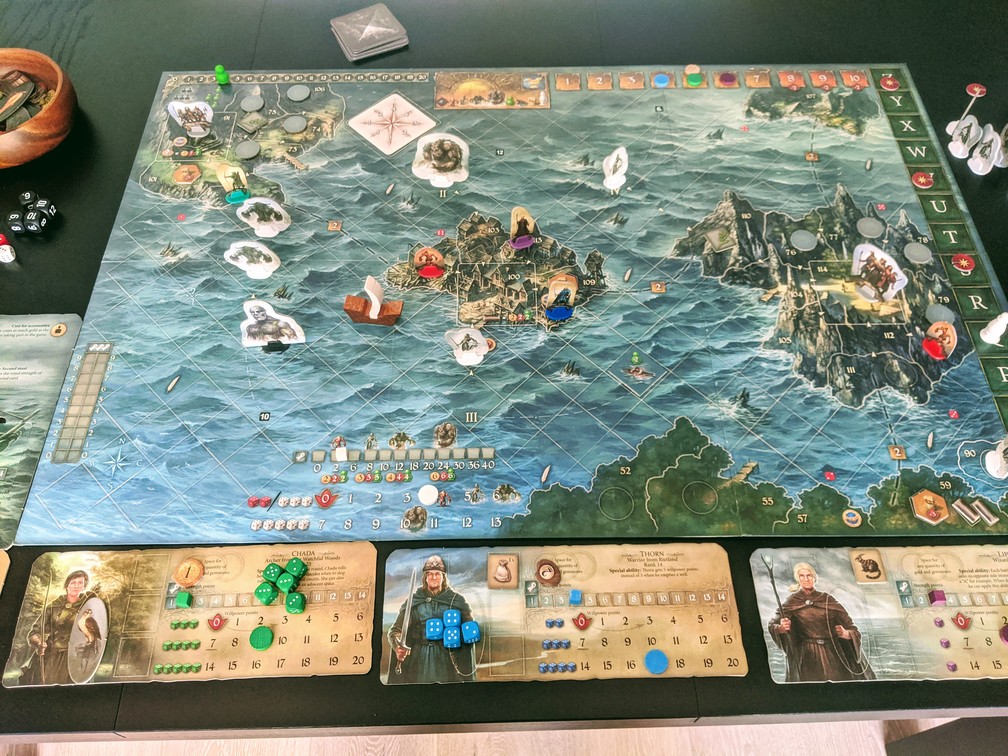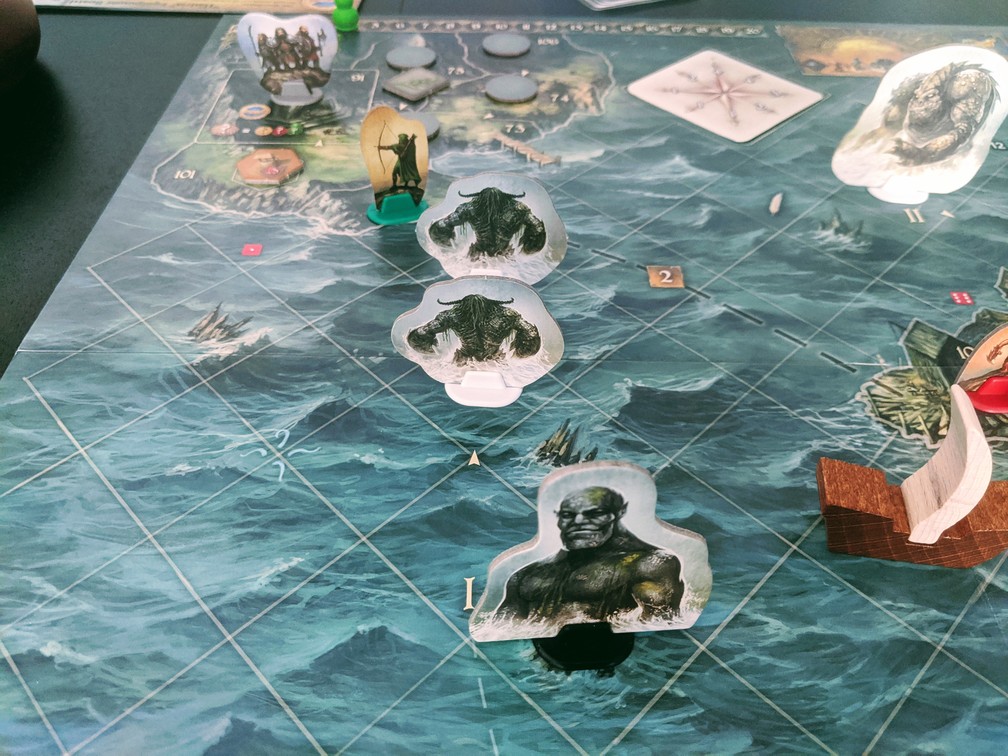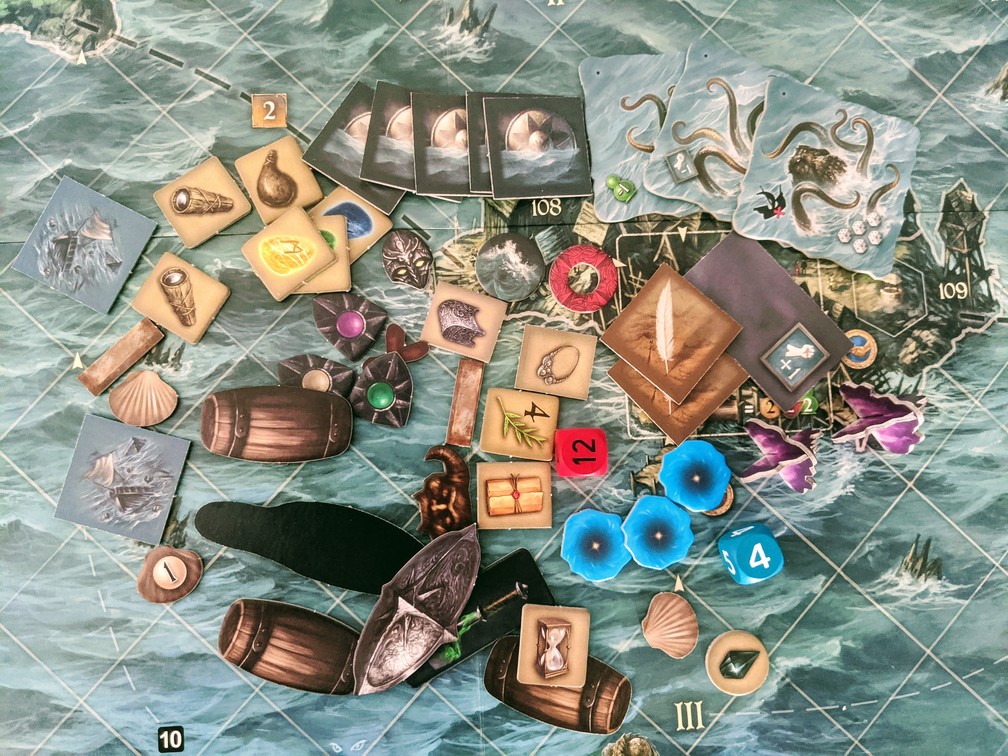“Okay, I can get the wizard to the 108 and then you can pick me up with the ship.”
“Umm, I can’t go that far in one round.”
“What if we use Stianna’s compass to shift the wind?”
“Okay, yeah, that works. So you’ll hop in, then the archer can take us there, we’ll kill that sea troll, take the money, and then go back to upgrade the ship.”
“Someone also has to take the shells to the dwarfs.”
“Maybe Thorn can walk from the shipyard?”
“But what if a storm takes the ship all the way across the map? It would take a whole round to meet up again. And we need all four heroes for an arrog fight.”
“I have one more turn on the stormshield, we’ll manage.”
Journey to the North is an expansion to the critically acclaimed Legends Of Andor. Well, it was critically acclaimed by us. However, it is an expansion only in name because it is practically a standalone game. It is bigger, bolder, and overall better than the base game, but more on that later.
After the great victory over Tarok the dragon in Andor, the wizard receives a vision that Hadria, his homeland, is in danger (apologies to all the female wizard players, in our game the wizard is a he). There is a charming comic strip about the heroes demanding a ship from the king, and the king reluctantly agreeing to give them a tiny old boat that has no weapons or proper cargo hold. I think the king was just being a jerk, there is no way the great kingdom of Andor has no ships. How do they trade? Maybe they don’t and that is why King Thorald is so unpopular.
So our heroes set out on their shaggy boat to cross the northern great sea. During the journey, they realize that no one actually knows how to get to Hadria, not even the wizard who was born there, so they spend most of the game trying to find their way through the Fog Islands. In defense of the heroes, they do try to find a cartographer as soon as possible to help them with the navigation.

For this review, we are going to use a different structure since it is impossible to talk about Journey to the North without constantly comparing it to the base game. Instead of The Good and The Bad, we will talk about The Same, The Better, and The Worse.
The Same
The gameplay is pretty similar to the base game with small tweaks. The playable characters are also the same, except there is no dwarf since he is busy, and the sea warrior hero is added to the roster, which is a good thing since he/she is the only one who knows anything about sailing.
Monsters now approach from the sea, as good sea monsters should, and killing them earns fame for the heroes. However, leaving them to pillage the Fog Islandsdecreases fame. If the fame ever reaches zero you immediately lose the game. All this makes sense thematically, imagine the poor islanders living in constant fear of monsters and then these weird foreign people show up on a dingy boat, they need to earn the trust of the people.
The general structure of the game is the same, you have your legend decks, narrator, heaps of random tokens, predetermined monster movements, combat, etc. The fiddliness level hasn’t changed either, you have to roll the dice 7 times to determine where things should be on the board before every single scenario, new rules get introduced on legend cards so the rule book is still not comprehensive, and there are lots of single-use tokens all over the legends. Combine this with the fact that some tokens come from the base game and the overall result is pretty messy. Perhaps even messier than the base game.
The artwork is still great, the map is just gorgeous. I think I like this one even more than the base game’s map because of the beautiful sea.
The Better
The ship might be an embarrassment of naval architecture but as a game mechanism, it is AWESOME. You get to take the others with you on sea rides, and you can fight huge trolls in the middle of the sea with it. And there is a really cool wooden mini included in the game, along with a separate ship board with flippable pieces for upgrades. The ship also makes the pacing of the game faster since you can get across the map in a couple of moves and also makes it easier to explore everything. In the base game, there are places on the main map where we just never went, they were far away from the main castle and usually nothing happened there. In Journey to the North, you get to see everything because of your mobility.
The game also offers new and interesting choices, like what to upgrade on the ship, what to choose as a reward for killing monsters, collect the shells or the logs (it sounds stupid but if you play this game you will have a conversation about these), how to carry all the stuff across the sea, who should be on the ship, where to drop the heroes off, risk weathering storms on the ship or not, and so on. There are dozens of things to argue about at any given minute during gameplay.
Thankfully the narrator in Journey to the North only advances after every second kill, so you get to slay more monsters. In the base game, you lost precious time after every single kill and it made slaughtering monsters too methodical and calculated, it lacked the zealous feeling of heroically saving the villagers from rampaging trolls. You still can’t just go about murdering willy-nilly, but having more combat enhances the theme of the game.
The stakes are also higher. In the base game, you had to calculate precisely how many creatures you can let into the castle and how to strategically kill a couple to avoid mass movement cascades. In the end, even if you won the legend, the land around the castle would be overrun. However, in the expansion, the monsters pillaging the islands will cause a fame penalty every single round they are on land, so you can’t really ignore them. You also have to watch out for triggering new legend cards because an unlucky gor spawn could cost you the game. For example, let’s assume you have just killed a troll to have enough fame to survive the reputation hit due to the two monsters currently rampaging through the islands. The kill triggers a new legend card which spawns two more gors on land. You only have two more hours left from the day, there is no way you can get to those, so you just lost the entire legend. Better luck next time.

To add to the already tangible tension, the game made the average creature more powerful, for example, the arrog has 24 strength! It is not even a boss, just a regular monster that can show up any time, how on earth would you defeat that?
There is also more variability in the game and among the legends. For example, in one legend parts of the islands can sink and you might end saving survivors, in others, the main threat is a random legendary sea monster. The setup gives the game great replayability and makes it exciting when you read the new legend cards during your replays.
Another great feature this expansion introduces is choice. Not a lot, but in one legend you can decide who to team up with and it actually vastly changes the rest of the legend. Isn’t that amazing? You also get to wield ancient magical weapons in some circumstances that for the first time in the game series make you feel truly powerful.
Thankfully they abandoned the event deck from the main game since it was really random and not very impactful. In the expansion, the random element is the wind card, which determines the strength of the winds and how fast you can travel in each direction. It can also trigger storms and move your ship to random locations. This is much more thematic than completely random events that are totally disconnected from the story.
In our review of the base game, we mentioned that the path to victory is generally the same in each legend. You buff up the dwarf at the mine, get the runestones for the wizard, buy a helm for the warrior, etc. In Journey to the North, however, they managed to muddy it. It is not evident from the beginning how you should tackle the problem. Should you max out the ship first? Or should you save the money to buy strength? Also, how will you get money because you also have to manage fame? All these little moving parts made the game much more exciting.
The last legend is on the other side of the map, and it really feels like a culmination of the story. You have spent so much time mapping the sea that it is a great feeling to finally reach the infamous Hadria. You get to this strange and mysterious snowy land where sorcerers battle each other and an evil lurks in the shadows. The final map adds so much new stuff to the game that it could be a small expansion on its own. For example, during the night it snows, and magical objects appear under the snow cover that you can discover the next day. It could be a portal, or an eternal flame, or some less exciting ice or twigs or frostbite. It really adds to the variability and excitement of the game.
The Worse
I mentioned above that variability is great in this game. However, to be fair, the side missions can get a little bit boring after a while. The first time you need to ferry three dudes across the islands is cute. The next time it feels more like a chore. Most of the side missions require you to take something or multiple things from one island to another. According to the story, it seems like you are the only one with a ship in the area, which is just stupid. How could an island nation survive without ships?
The fog tokens also suck in this expansion, the cost of placing a new gor somewhere is too high, therefore it is really not worth exploring them.
The random-token-syndrome is much worse than in the base game. For one of the legends you have these large rectangular tokens that contain an event and an icon that depicts plus one strength for the monsters, but it is only used in one legend. That’s it. There is also one flood token, one necklace, one small chest, all used one single time. It does not feel elegant, the game comes off poorly designed, it just lacks creativity.

In the “Better” section I mentioned how killing monsters is more intense and how you can end up losing the game because of a random monster spawn. Well, on the one hand, it is exciting, on the other, it really sucks if it happens. The spawning locations are just much more random than in the base game, where creatures usually spawned far away from the castle, so they didn’t immediately ruin all your plans. In Journey to the North, a random puny little gor can mess up your whole carefully planned strategy.
And lastly, the pacing of the last legend is a bit weird. Around the middle of the scenario, you have to choose a faction to support and then “take care” of the other. It is a great story moment and the fight is really epic no matter who you choose to side with. However, one of the routes lead to a huge advantage for the rest of the legend and makes beating the final-final boss easy peasy lemon squeezy. You end up with a final legend where the most memorable and epic fight is with the mini-bosses in the middle game instead of the huge final boss at the end. I don’t necessarily need it to be as harsh and unforgiving as beating the dragon in the base game, but in this case, it was really anti-climactic.
The Co-Op
Same as the base game, great.
The Recommendation
If you liked the base game you will love Journey to the North. If you didn’t then I don’t think anything I say could make you buy an expansion for a game you don’t enjoy.
Info
| Release Year | 2014 |
| Genre | Puzzle, Strategy |
| Difficulty | Extreme |
| Number of Players | 2 to 4 |
| Length | 2 hours per Legend |
Rating
| Overall | Great |
| Story | Great |
| Co-Operation | Great |